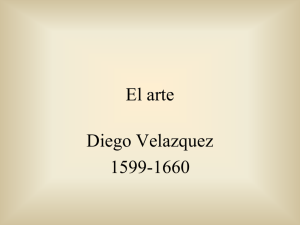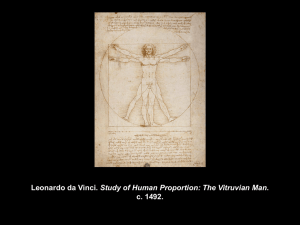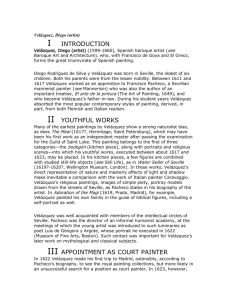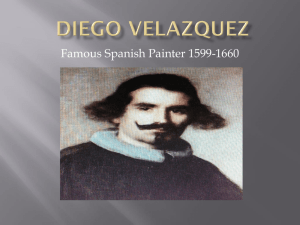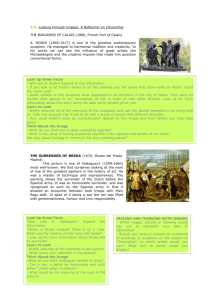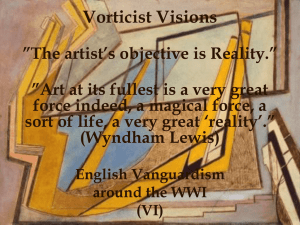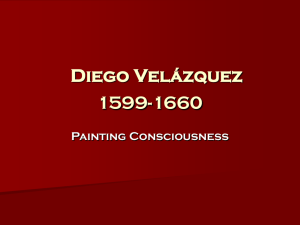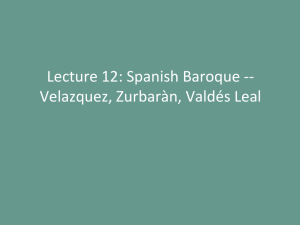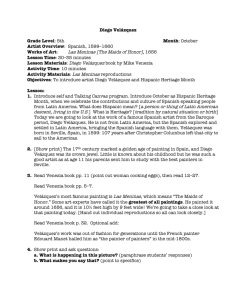Velasques, by Lorena Baric
advertisement
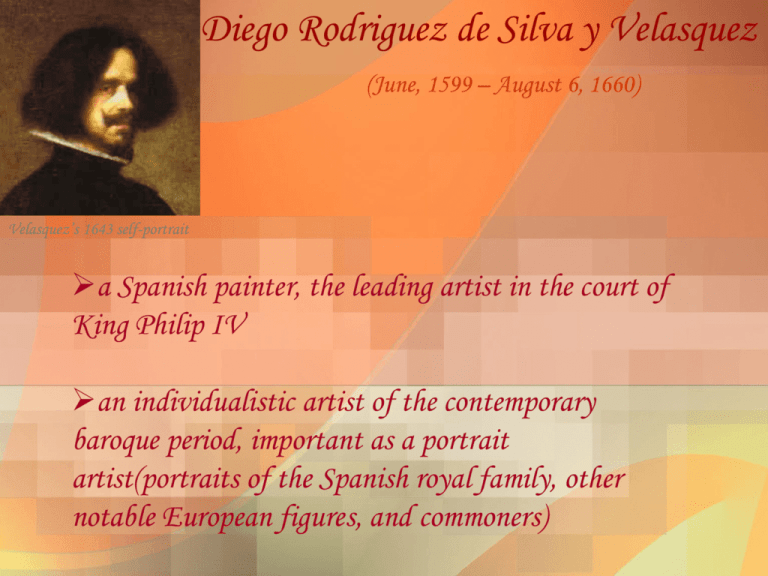
Diego Rodriguez de Silva y Velasquez (June, 1599 – August 6, 1660) Velasquez’s 1643 self-portrait a Spanish painter, the leading artist in the court of King Philip IV an individualistic artist of the contemporary baroque period, important as a portrait artist(portraits of the Spanish royal family, other notable European figures, and commoners) Early Life Velasquez was born in Seville, Andalusia early in June 1599.He was the son of Juan Rodríguez de Silva, a lawyer of noble Portuguese descent, and Jerónima Velázquez, a member of Seville's hidalgo class, an order of minor aristocracy (it was a Spanish custom, in order to maintain a legacy of maternal inheritance, for the eldest male to adopt the name of his mother) He was educated by his parents to fear God and, intended for a learned profession, received good training in languages and philosophy. But he showed an early gift for art; consequently, he began to study under Francisco de Herrera, a vigorous painter who disregarded the Italian influence of the early Seville school. Velázquez remained with him for one year. It was probably from Herrera that he learned to use brushes with long bristles. After leaving Herrera's studio when he was 11 years old, Velázquez began to serve as an apprentice under the pedantic Francisco Pacheco, an artist and teacher in Seville. Velázquez remained in Pacheco's school for 5 years, studying proportion and perspective and witnessing the trends in the literary and artistic circles of Seville. The birth of realism in Seville Velázquez fell in love with Pacheco's daughter Juana, whom he married in 1618 with Pacheco's hearty approval. The young painter set himself to begin recreating in his art common things—earthenware jars of the country people, birds, fish, fruit and flowers of the marketplace. A notable piece from this early period of depicting common Spanish life is An Old Woman Frying Eggs, 1618. By the early 1620s his position and reputation were assured in Seville. Velázquez produced other notable works in this time. Sacred subjects are depicted in The Adoration of the Magi,1619, and Christ and the Pilgrims of Emmaus, 1626,both of which begin An Old Woman Frying Eggs, 1618 to express his more pointed and careful realism The Adoration of the Magi, 1619 To Madrid Velázquez went to Madrid in the 2nd half of April 1622, with letters of introduction to Don Juan de Fonseca, himself from Seville, who was chaplain to the King. December 1622, Velázquez the command to come to the Court from the Count-Duke of Olivares, the powerful minister of Philip IV. A portrait of the King was commissioned. On August 16, 1623, the King sat for Velázquez. Complete in one day the portrait was likely to have been no more than a head sketch, but both the King and Olivares were pleased. Olivares commanded Velázquez to move his home to Madrid, promising that no other painter would ever paint the King's portrait and all other portraits of the King would be withdrawn from circulation. A 1628 portrait of Philip IV Phillip IV in Armour, 1628 In September 1628 Rubens came to Madrid as an emissary from the Infanta Isabella, and Velázquez kept his company. Rubens was then at the height of his powers. The seven months of the diplomatic mission showed Rubens' brilliance as painter and courtier. Rubens had a high opinion of Velázquez, but he effected no great change in his painting. He reinforced Velázquez's desire to see Italy and the works of the great Italian masters. In 1627, Philip set a competition for the best painters of Spain. Velázquez won. His picture was destroyed in a fire at the palace in 1734. Velázquez was appointed gentleman usher as reward 1629, The Feast of Bacchus. The painting is firm and solid, and the light and shade are more deftly handled than in former works. Altogether, this production may be taken as the most advanced example of the first style of Velázquez. The Feast of Bacchus, 1628/29 Velázquez's Italian period First visit to Italy In 1629 he sailed from Barcelona In Venice Velázquez made copies of Tintoretto's Crucifixion and Last Supper which he sent to the king, and in Rome he copied Michelangelo and Raphael, lodging in the Villa Medici till fever compelled him to retire into the city. Here he painted The Forge of Vulcano,1630 The Forge of Vulcano, 1630 In Rome Velázquez also painted two beautiful landscapes of the gardens of the Villa Medici. Landscape was uncommon in Spanish art, but Velázquez showed how capable he was in this branch as well . Villa Medici in Rome (Pavilion of Ariadne), 1630 Villa Medici in Rome (Facade of the Grotto-Logia Then a visit to Naples in 1631, where he worked with his countryman José Ribera and painted a charming portrait of the Infanta Maria, sister of Philip, Velázquez returned early in the year to Madrid Infanta Maria, Later Queen of Hungary Return to Madrid (middle period) The Surrender of Breda, 1634-35, was inspired by Velázquez's first visit to Italy, in which he accompanied Ambrosio Spínola, who conquered the Dutch city of Breda a few years prior. This masterwork depicts a transfer of the key to the city from the Dutch to the Spanish army. The powerful minister Olivares was the early and constant patron of the painter. During Olivares’fall from power, Velasquez was loyal to his patron, exposing himself to the great risk of the anger of the jealous Philip. The king, however, showed no sign of malice towards his favorite painter Velázquez was in constant and close attendance on Philip, accompanying him in his journeys to Aragon in 1642 and 1644, and was doubtless present with him when he entered Lerida as a conqueror Velázquez's portraiture Besides the forty portraits of Philip by Velázquez, he painted portraits of other members of the royal family: Philip's first wife, Isabella of Bourbon, and her children, especially her eldest son, Don Baltasar Carlos, of whom there is a beautiful full-length in a private room at Buckingham Palace Prince Baltasar Carlos with a Dwarf, 1631 Religious paintings The greatest of the religious paintings by Velázquez also belongs to this middle period, Christ on the Cross, 1632. It is a work of tremendous originality, depicting Christ immediately after death. The Savior's head hangs on his breast and a mass of dark tangled hair conceals part of the face Christ on the Cross, 1631 Second Visit to Italy Accompanied by his slave Pareja, whom he trained in painting, Velázquez sailed to Italy.He bought paintings of Titian, Tintoretto and Veronese as he went. At Modena he was received with much favor by the duke, and here he painted the portrait of the duke at the Modena gallery and two portraits that now adorn the Dresden gallery, for these paintings came from the Modena sale of 1746. Those works presage the advent of the painter's third and latest manner, a noble example of which is the great portrait of Pope Innocent X in the Doria Pamphilj Gallery in Rome, where Velázquez now proceeded. 1650 portrait of Pope Innocent X In 1650 in Rome Velázquez also painted a portrait of his servant, Juan de Pareja, now in the Metropolitan Museum of Art in New York City Juan de Pareja, 1650 Return to Spain (later period) King Philip wished that Velázquez return to Spain. Yet far from indicating any decline, his works of this period are amongst the highest examples of his style. Margarita, the eldest daughter of the new Queen, is the subject of The Maids of Honor, 1656.Created four years before his death, it is a staple of the European baroque period of art Final years Had it not been for this royal appointment, which enabled Velázquez to escape the censorship of the Inquisition, he would not have been able to release his Venus at her Mirror, 1651, also known as The Rokeby Venus. It is the only surviving female nude by Velázquez Venice at her Mirror, 1651 One of his final works was The Spinners, painted around 1657, representing the interior of the royal tapestry works. Starting in the 1st quarter of the 19th century, Velázquez's artwork proved a model for the realist and impressionist painters, in particular Édouard Manet. Since that time, more modern artists, including Spain's Pablo Picasso and Salvador Dalí, have paid tribute to Velázquez by recreating several of his most famous works Sources: Velasquez’s 1643 self-portrait (http://www.abcgallery.com/V/velazquez/velazquez.html) An Old Woman Frying Eggs, 1618 (http://www.abcgallery.com/V/velazquez/velazquez7.html) The Adoration of the Magi, 1619 (http://www.abcgallery.com/V/velazquez/velazquez11.html) A 1628 portrait of Philip IV (http://www.abcgallery.com/V/velazquez/velazquez64.html) Phillip IV in Armour, 1628 (http://www.abcgallery.com/V/velazquez/velazquez21.html) The Feast of Bacchus, 1628/29 (http://www.abcgallery.com/V/velazquez/velazquez14.html) The Forge of Vulcano, 1630 (http://www.abcgallery.com/V/velazquez/velazquez16.html) Sources: Villa Medici in Rome (Pavilion of Ariadne), 1630 http://www.abcgallery.com/V/velazquez/velazq uez18.html Villa Medici in Rome (Facade of the GrottoLogia) http://www.abcgallery.com/V/velazquez/velazq uez19.html Infanta Maria, Later Queen of Hungary (http://www.abcgallery.com/V/velazquez/velaz quez22.html) Prince Baltasar Carlos with a Dwarf, 1631 (http://www.abcgallery.com/V/velazquez/velaz quez25.html) Christ on the Cross, 1631 (http://www.abcgallery.com/V/velazquez/velaz quez69.html) Sources: 1650 portrait of Pope Innocent X (http://en.wikipedia.org/wiki/Diego_Vel%C3%A1zquez) Juan de Pareja, 1650 (http://www.abcgallery.com/V/velazquez/velazquez44.html) Las Meninas, 1656 (http://www.abcgallery.com/V/velazquez/velazquez48.html) Venice at her Mirror, 1651 (http://www.abcgallery.com/V/velazquez/velazquez50.html) The Spinners, 1657 (http://www.ssga.ru/erudites_info/art/velasces/pict/7_55_1.jpg) Text: 1. http://en.wikipedia.org/wiki/Diego_Vel%C3%A1zquez 2. http://www.abcgallery.com/V/velazquez/velazquez.html
